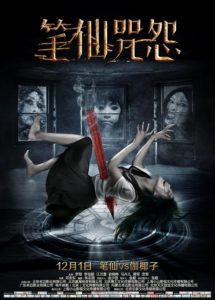Bunshinsaba
笔仙咒怨
China, 2017, colour, 2.35:1, 84 mins.
Director: Deng Andong 邓安东.
Rating: 5/10.
Generic but quite thoughtful riff on the low-budget Mainland horror cycle.
Xidian township, southern China, the present day, late May. University psychology student He Qianqian (Li Jiaying) arrives with her fellow student and best friend Jiang Jiaqi (Jiang Lanxuan) to visit her grandmother (Gu Qingyun) as well as some old junior high-school friends she hasn’t seen for years. The two girls are met at the train station by Wang Xiaofeng (Luo Xiang), whom He Qianqian once had a crush on; he’s now married to classmate Liu Fangfang (Yu Xiaoye) and the couple have a young child. At the house they’re also met by old classmates Ling Fei (Ma Hui) and Fattie Feng (Xu Yong). He Qianqian hears that her grandmother is not well, and has been harrassed by a local developer, An Dong (Fa Ge), whose family once owned the house and who now wants to pull it down. The grandmother had been using the old courtyard-style building as a shelter for homeless old people, but most have left. The problem is that she can’t find the title deeds to prove her ownership. The girls used to play ouija board at high school together; so Li Fangfang, who’s heard the developer is very superstitious, suggests they have a session to summon up the spirit Bixian to “haunt” the building for a while to drive him away. The session doesn’t seem to go well but He Qianqian still suggests all her friends stay the night. Weird events then start to happen, with Ling Fei being spooked out first.
REVIEW
No, not the 2004 South Korean horror, nor even the 2012 Chinese one by the same film-maker, An Byeong-gi 안병기 | 安兵基. Seemingly one of many Mainland rip-offs of An’s ouija-board horror cycle that ran from 2012 to 2014, this Bunshinsaba 笔仙咒怨 calmly borrows the English title but is otherwise all original and (within genre limits) quite thoughtful. Just as in his first horror outing, Nightmare Call 诡梦凶铃 (2015), Guangdong-born film-maker Deng Andong 邓安东, 32, re-thought the Mainland genre beyond it-was-all-a-dream or blame-it-on-drugs, so here he comes up with something that makes logical sense, as well as having some fun with the whole idea. This time he’s handed script duties to Heilongjiang-born writer/academic Lin Zhiguo 林志国 – who’d already written Bikini Party 比基尼派对 (2016) and online movie Black and White: Yoga Little Lolita 痞子大叔 (2016) for him – and the result, while always generic and higher on atmosphere than real shocks (what Mainland horror isn’t?), is professionally mounted, smoothly edited and builds sequences with a refreshing disdain for visual flash.
From the care it takes at the end to tie up all the plot strands to the way in which it favours conservative film-making techniques – the film has no VFX – this Bunshinsaba is more than just another quickie rip-off. Lin’s screenplay centres on the idea of a group of ex-classmates who, via a ouija-board, ask the help of female spirit Bixian 笔仙 (“pen fairy”) to haunt an old mansion in order to deter a developer who wants to knock it down. The twist is that Bixian is seen here as a friendly spirit who stands for justice; but as soon as she’s done her job and the developer has fled, an evil spirit appears – the spider-like Kayako 伽椰子, gleefully appropriated from the Japanese movie series Ju-on 呪怨 (aka The Grudge, 2000- ). In fact, the film’s Chinese title can be read as either “Bixian’s Grudge” or just “Bixian The Grudge”, neatly hooking a ride on both franchises.
The film’s poster describes the film as “Bixian vs Kayako” 笔仙VS伽椰子 (read: Chinese ghost vs Japanese ghost) but their cross-cultural battle makes up only a tiny part of the finale and is not the basis of the whole movie. It’s one of several sleights-of-hand that this Bunshinsaba craftly plays, pulling the rug from under the audience’s expectations. And by inserting Kayako into the plot, the film not only has some fun with the whole genre but also tips its hat to another cross-cultural mash-up – the slick iQiyi online movies Bunshinsaba vs Sadako 笔仙大战贞子 (2016) and Bunshinsaba vs Sadako 2 笔仙大战贞子2 (2017) that co-opted the vengeful female spirit of Ring リング (1998).
Performances range from bland (the soppy male lead played by actor-singer Luo Xiang 罗翔, 27, a low-budget horror regular) to theatrical (Fa Ge 发哥 as the sneering developer) but are generally serviceable and sometimes more so, such as Jiang Lanxuan 江兰萱 (also in Deng’s zombie movie The Living Dead Invasion 活死人入侵, 2017) as a lightly comic scream queen and Yu Xiaoye 俞晓晔 quite classy as a jealous young wife.
“Bunshinsaba” is simply a nonsense word, like “abracadabra”, that was originally invented by An as an invocation when playing with a ouija board. The Chinese “Bixian” is actually the name of the ouija board’s guiding female spirit – here portrayed as good rather than evil. The film was shot around Sangzhou township, south of Ningbo, though most of the action is set inside an old courtyard-style house which could be anywhere.
CREDITS
Presented by Beijing Drama Film & TV Production (CN). Produced by Beijing Drama Film & TV Production (CN).
Script: Lin Zhiguo. Photography: Huang Kewen. Editing: Li Jian. Music: uncredited. Art direction: Deng Andong. Costumes: Zhao Ying, Yu Huijie. Sound: Sun Xinghua, Xu Hongfei. Action: Ma Ke. Special effects: Wang Xiaoyang, Wang Zhiliang. Executive direction: Li Zhuo.
Cast: Luo Xiang (Wang Xiaofeng), Li Jiaying (He Qianqian), Jiang Lanxuan (Jiang Jiaqi), Yu Xiaoye (Liu Fangfang), Xu Yong (Feng Pangzi/Fattie), Ma Hui (Ling Fei), Fa Ge [Zheng Xiaoyong] (An Dong, property developer), Gu Qingyun (Huang, grandmother), Li Jun (Li Ming), Zhang Guodong (Han Dayu, An Dong’s sidekick), Yang Kexin (An Dong’s elder daughter), Fang Shengnan (An Dong’s younger daughter).
Release: China, 1 Dec 2017.
